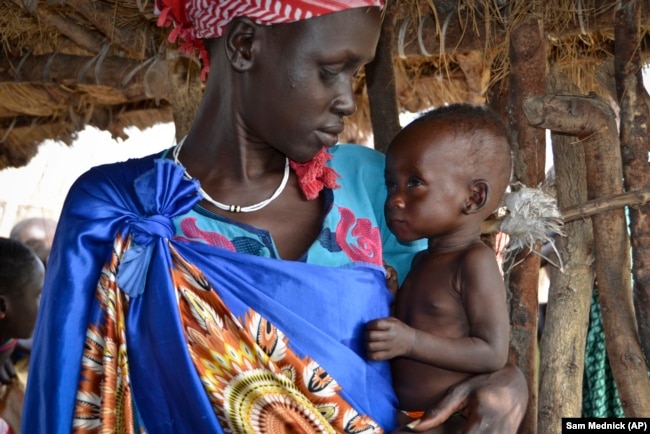Civil War Leads South Sudan Closer to Starvation

As Bob Wol lay on the dirt floor of his home in intense pain, he touched each of the gunshots on his thigh and back.
The 29 year-old man from South Sudan told the Associated Press, “I was trying to get food and my government tried to kill me.”
It has been almost 25 years since more than 1 million people came close to starvation in southern Sudan. A Pulitzer Prize-winning photograph of a vulture standing near a starving little girl captured the story of the crisis for all the world to see.
Today, people in the area that was known as the “famine triangle” say the situation has only gotten worse.
Famine spreading during civil war
South Sudan has been involved a civil war for 5 years now. The latest research from the country’s government and the United Nations has found that 1.25 million people are facing starvation. And the U.N. warns that if the fighting continues, famine will spread to other parts of the country by early next year.
This means almost half the population of 11 million people will be severely lacking in food.
Wol told the Associated Press he was desperate to feed his wife and five small children, who had not eaten in days. So he went in search of help. After six days of walking and eating fruit he picked from trees, Wol reached the government-held town of Ayod. There, he said, soldiers concerned about rebels attacked him by surprise.
“When I got shot I was just thinking that I didn’t want to die before I got food for my family,” Wol said. “We’re locked in here and we can’t get out.”
Lony Toang survived an earlier famine in Ayod County. Toang said, “Before, only the hunger was killing you. … Now it’s worse because we have hunger and we’re killing people.”
Ayod is one of two counties in South Sudan currently in crisis, with 8,000 people experiencing extreme hunger. The rebels’ main base of operations in Ayod County is the town of Jiech.
The county of almost 160,000 people in Jonglei State is hard to reach, difficult to produce food in and separated from most of the nation. The fighting has greatly harmed the area.
South Sudan’s army rejected people’s stories of intense violence as negative propaganda from the rebels. It stated that it is not government policy to prevent citizens from reaching aid.
Yet across South Sudan there are many claims of both the government and the rebels using food as a weapon of war.
People are caught between opposing forces
The Associated Press spoke with people in the towns of Yei and Lainya during a visit to the Equatoria area last month. They said the army believed some civilians trying to produce food in their fields were rebels.
Mary Yata lives in Lainya. She said four government soldiers in September tried to steal vegetables when she was working in her fields.
“They said if I didn’t leave now they’d kill me,” she said. Days later she saw the soldiers selling her vegetables at the market.
Rights groups are calling on the warring sides to stop holding South Sudan’s people hostage.
Donatella Rovera is Amnesty International’s senior crisis response adviser. She said, “The civilians are caught in a deadly circle and they’re … not being protected.”
The people of Ayod said they have nowhere else to go. So they will continue to depend on aid from the U.N.’s World Food Program.
At a food distribution last week, 11,000 hungry people arrived from the surrounding countryside. Some had walked over night to receive cooking oil and other simple food items.
The World Food Program, or WFP, has increased its distributions from every 90 days to every 60 days. But aid workers on the ground say the food is enough for just one month.
Ewnetu Yohannes is a team leader for Catholic Relief Services, the organization leading the distribution. Yohannes said, “I saw old people collecting grains that fell on the ground… If WFP wasn’t here it’d be a catastrophe.”
Elizabeth Nyakoda lives in Jiech, and she blamed the hunger on the years of fighting. The 35-year-old mother of five was unable to register in time for the aid distribution and too scared to work her fields.
She placed her hand on her starving child’s stomach and looked away as the baby began to cry.
“When the child cries from hunger, what can I do for her?” she said. “There are no options.”
I’m Susan Shand. And I'm Pete Musto.














Add new comment